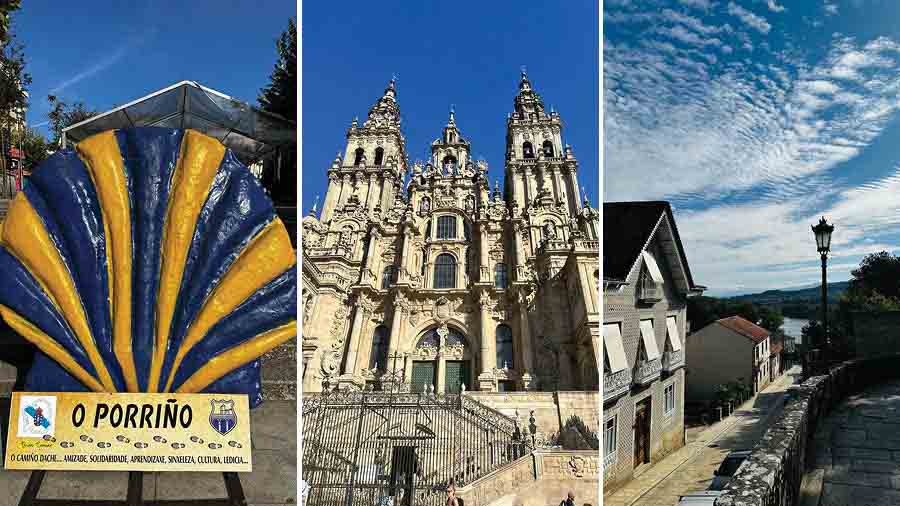Galicia, an autonomous community of Spain, is nestled in the north-western corner of the Iberian peninsula. Even though it is part of Spain’s dazzling diversity, its language is closely connected to Portuguese and its seafood-centric cuisine is distinctive. Its sun-drenched landscape of hills, vineyards, patches of woodlands and a long Atlantic coastline is interspersed with historic towns and cities.
The main city of Santiago de Compostela, with its beautifully preserved mediaeval architecture, cobblestone streets and an old Romanesque cathedral, has been a popular pilgrimage destination across Europe for centuries. In recent times, it has started attracting a lot of tourists and pilgrims from across the globe, most notably from the US. Known as El Camino or “the way”, the pilgrimage to Compostela can commence from multiple points across Spain, Portugal and France, an acknowledgment that pilgrims have different contexts and vantage points in life. But all routes ultimately converge on that bright sunlit square of the Compostela cathedral where St James of Jerusalem is laid to rest.
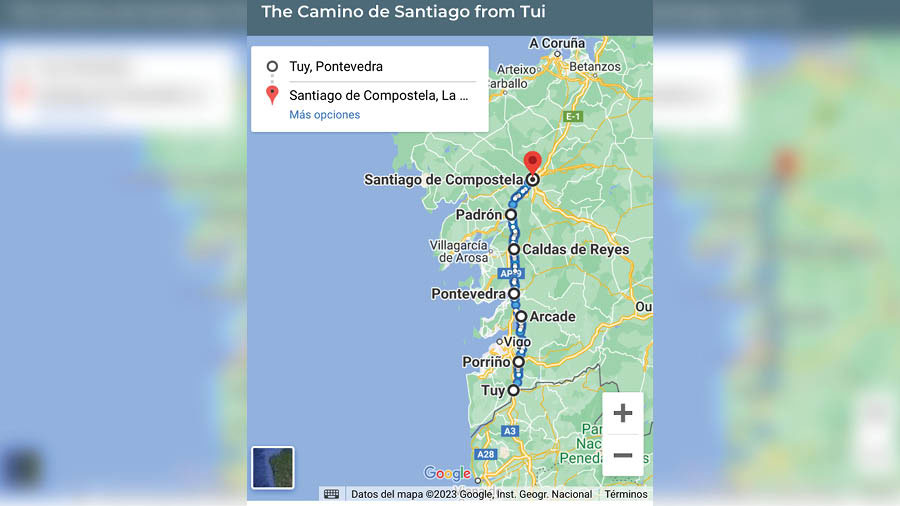
A map showing the route of El Camino that the author took
Apart from a friend goading me to undertake this pilgrimage, there were two reasons for embarking on El Camino. First, it represented a welcome return to travelling on foot among local people in a foreign land. Far away from the kind of hypercommercialisation that has been the ruin of many places, Galicia seems to have escaped the fate of the boxed spectacle of mass tourism. Second, being faithless for most of my life, my recent interest in spirituality and faith have been kindled by personal events, some accidental and some planned.
In India, we have the Char Dham Yatra, the 12 Jyotirlinga sites of Shiva as well as the 108 Shakti Pithas, not to mention the countless local shrines spread across the length and breadth of the Indian subcontinent. These pilgrimages play a vital role in providing a unifying story and theme around which a diverse population can develop a common civilisational culture. Likewise in Europe, pilgrimages such as El Camino serve to unite people from diverse nationalities of Europe into the kingdom of Christendom.
With limited days available and a tempting phone call from my aforementioned friend setting off a chain of adjustments to my work and personal calendar, El Camino was imminent. With lots of support from colleagues, friends and family, the roving spirit prevailed. What followed was five days of an enriching pilgrimage.
Day 1: Tui to O Porrino and catching up with my friend
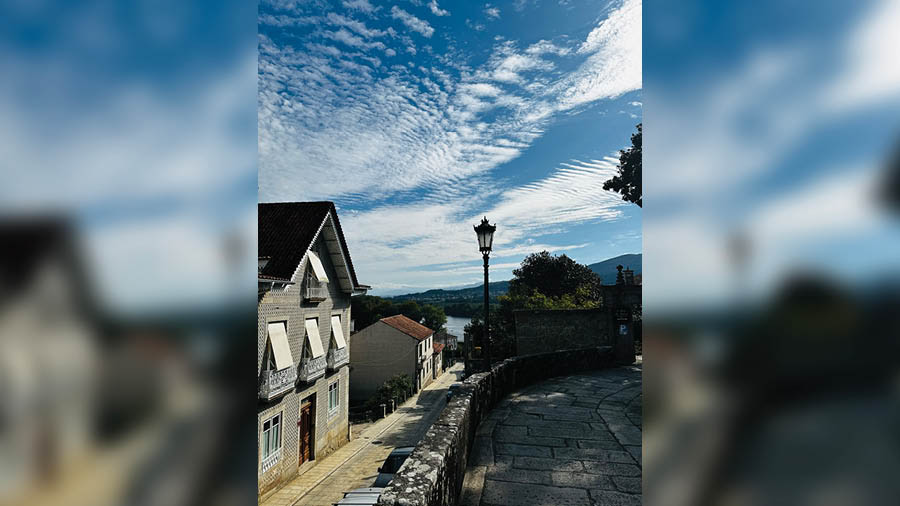
On the way to O Porrino
I landed early in the morning in the Vigo airport on a budget airline and took a cab to the starting point of my 120km odyssey to follow the path of St. James. St. James was one of the apostles of Jesus and the patron saint of Spain, whose mortal remains were brought from Jerusalem and interred at the grand cathedral in Compostela sometime in the 12th or 13th century. We took one of the shortest El Camino routes starting on the Portugal-Spain border and gradually walked our way northwards, through woodlands, gravel paths, highways and industrial zones to the shrine of St. James.
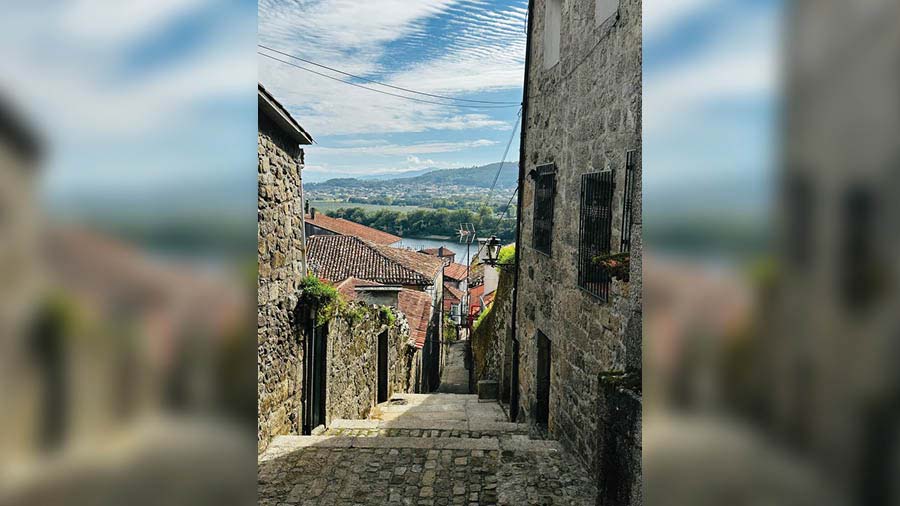
Somewhere on the outskirts of Tui
I dropped my luggage at a picturesque hotel on top of a hill and collected my Camino passport. At the starting point in Tui, in keeping with tradition, I rang the bell at the convent and bought some cookies. A blue uniformed nun appeared from behind a latticed wooden partition, evoking parallels in my mind to the purdah. She asked me in Galician which cookie I needed. I opted for the fish-shaped almond biscuits and was on my way. Later, when I opened the box, I realised she had packed a different set. My first attempt to communicate in Galician was a dismal failure.
After leaving Tui, the path traversed along the highway for a while before veering off into a wooden hard gravel path — the ancient Via Romana. The sun was out and it was warm. Butterflies and dragonflies were dancing in the bright sunlight. Every few kilometres, we crossed villages with their vineyards and bungalow-style houses. A few pilgrims crossed my path — an elderly couple from the US, a lady from Poland, a group of friends from Tenerife (an island in Spain). We were a mixed bunch. I finished day one in the town of O Porrino, which lay at the end of an industrial zone. I caught up with my friend who had arrived in Portugal the night before and started his morning walk earlier. The hotel receptionist, who was also the owner, informed me that the best eateries were closed as it was too early in the week. We had to make do with an Italian place. They had good salads.
Day two: O Porrino to Arcade and meeting a Tagore fan
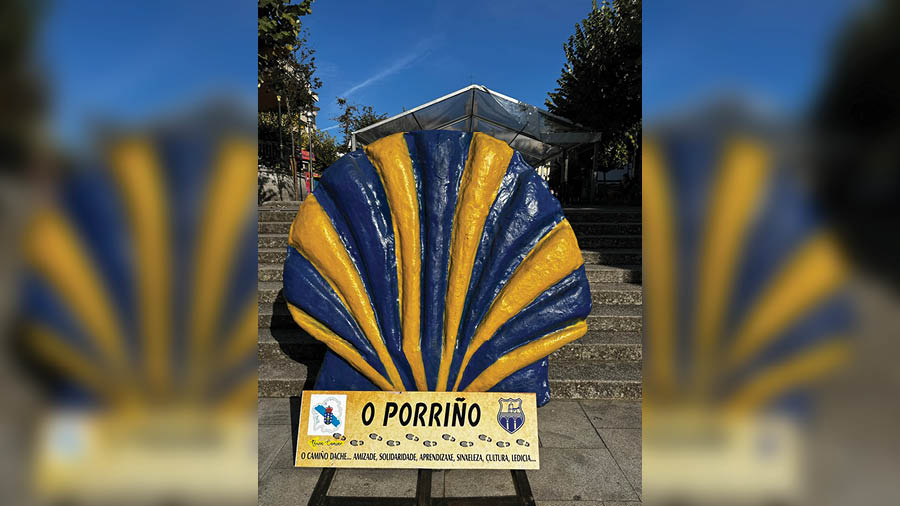
Setting off on day two from O Porrino
Given the late sunrise in Galicia, we started before dawn with a sumptuous breakfast. I was pleasantly surprised on being introduced to Jose, the owner of the neighbouring hotel, where my friend was staying. He had achieved the rare feat of reading Gora twice, the first time in English in his 20s and more recently in Spanish. In love with Tagore, he drew parallels between Kabiguru and Hermann Hesse. I have always kept a safe distance from Gora because of its voluminousness, but it was amazing to find such an admirer or Tagore in this corner of Galicia.
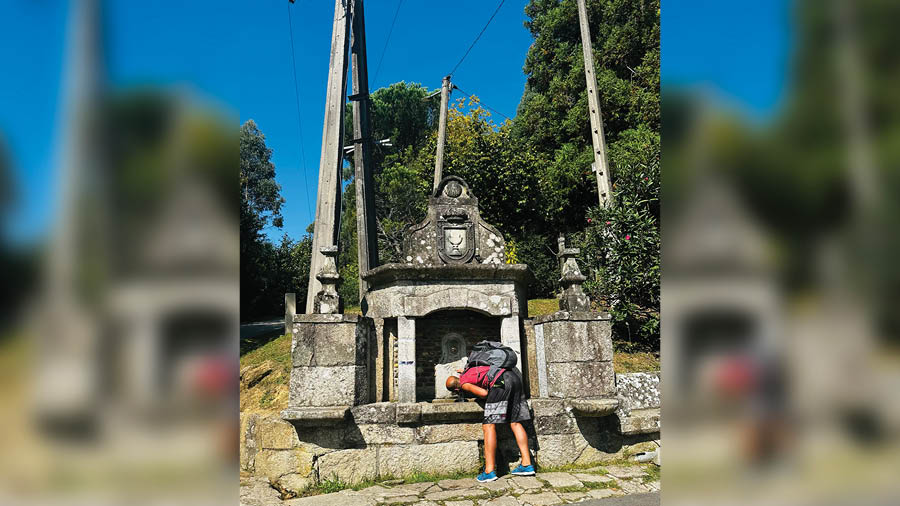
El Camino is dotted with water fountains for thirsty pilgrims
The route itself was more hilly and picturesque than day one. We crossed oak and pine forests as well as loads of sweet chestnut trees. The houses on the way were festooned with lantana, winter jasmine, evening primrose and calycanthus. The grape harvest was almost over and the grape vines were withering on the trellis. I liked the town of Redondela with its stone-paved narrow streets, before ending up on the outskirts of Arcade. The food along the way was awesome. Jamon, French fries, fresh sardines and a seafood platter with the octopus as the piece de resistance. I had not had such a tender and well-cooked octopus before.
Day three: Arcade to Caldas de Reis and blisters
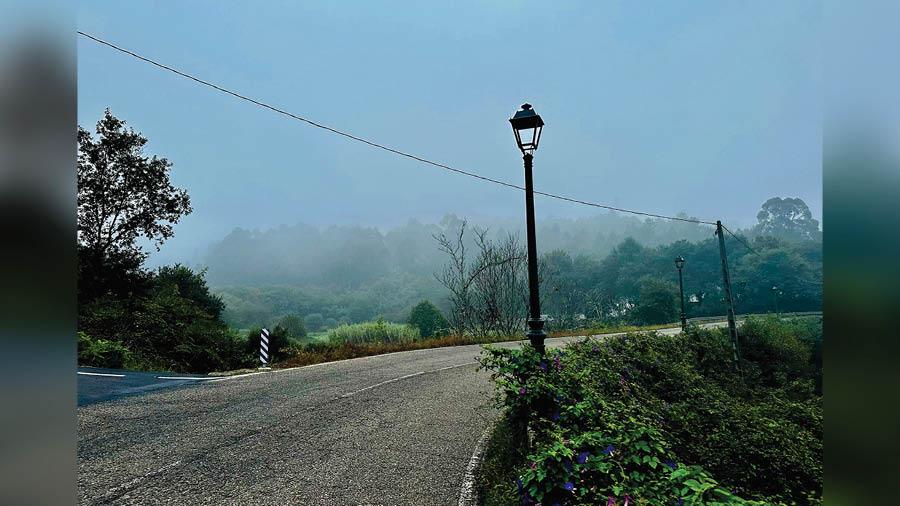
The third day began with mist
Day three was expected to be the toughest, with a 33km trek across hilly terrain, and it lived up to its expectations. Our day started with heavy fog, light mist and some rain, the kind that we often get in England. The journey to Pontevedra required climbing steep hills. We went through native forests of ash, willow and alder. Unlike what we had seen on the previous days, the eucalyptus invasion of the vegetation was limited.
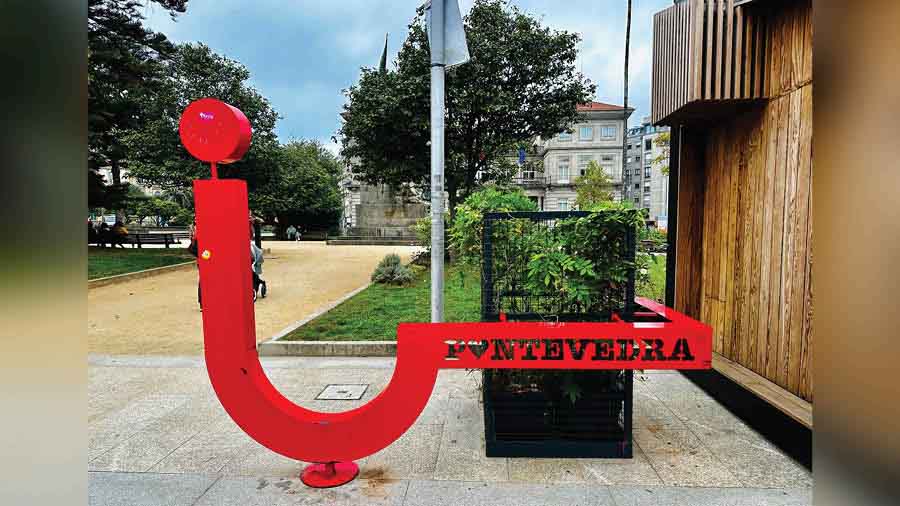
Passing through Pontevedra
After Pontevedra, the inclines eased up. The sun came out as we were walking under a canopy of vines heavy with grapes. By the time we were finishing at Caldas de Reis, my entire lower body was aching. I could feel blisters under my feet.
Day four: Caldas de Reis to Padron and a hearty local meal

Inside the main square next to the ruins of the Pontevedra cathedral
The scenery got better with each passing day. Caldas de Reis is a spa town with a hot spring to dip your feet in. We left a little late on day four as one of my fellow pilgrims had a bad case of blisters and needed to pick up trekking socks. Outside Caldas, the surroundings were mostly rural with pine-lined hilly trails occasionally shaded by acacia. The approach to Padron, a place famous for its mild chillies, was through a valley filled with red tiled houses and a white smoke belching factory in the municipality of Pontecesures. Padron, with a river running through it and trees lining the main square, reminded me of the Tuileries Garden in Paris. The old architecture did not disappoint. The evening ended with a nice Galician meal consisting of their fabled zamburini (scallops), poulpe (octopus), calamari, squid ink croquettes and, of course, the famous local Padron chillies.
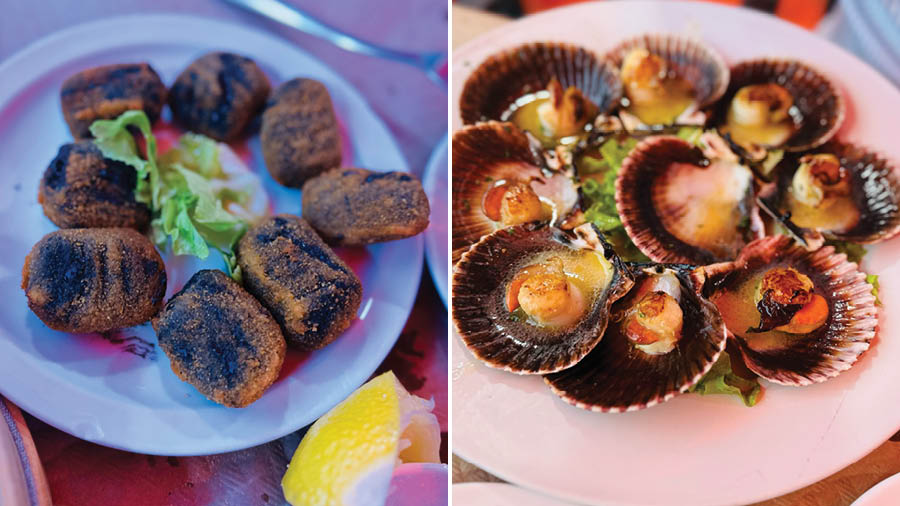
Squid ink croquettes (left) and zamburini
Throughout Galicia, we were amazed by the inclination of locals to dine communally in the evening and the absolute absence of any foreign cuisine. I could not find any Chinese, Indian or French restaurants. There was, though, a lonely Turkish eatery in Pontevedra. Galicia, safe to say, is very mono-cultural, untouched by global consumerism. People eat their sumptuous local food and there is hardly any provision for fast food.
Day five: Arrival at the Compostela cathedral and the universality of pilgrimage
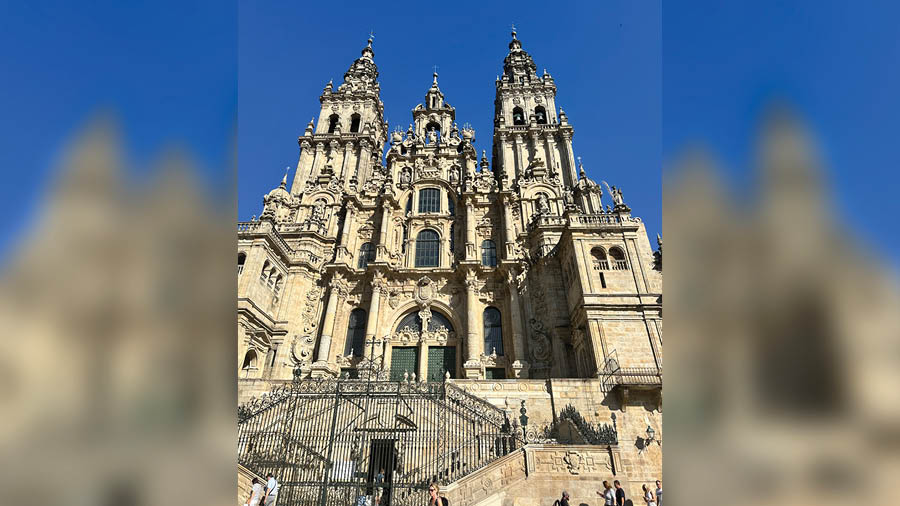
View of the Compostela cathedral from the Plaza del Obradoiro
The final approach to the Compostela cathedral is through a maze of narrow cobblestone alleyways. Groups of pilgrims in identical blue or orange t-shirts with ‘Camino’ emblazoned on them jostle together, chanting and singing as they approach the perimeter of the sacred structure. A glimpse of the baroque spire of the cathedral seems to add a sudden burst of energy as tired legs quicken and voices get excited. The imposing cathedral, set inside a large sunlit plaza, creates maximum visual impact when approached through dark, narrow streets. We arrived in the afternoon with legs numb with fatigue and feet covered in blisters after a 120km walk and approximately 1,80,000 steps over five days. But the cumulative energy of fellow pilgrims and the beautiful Romanesque architecture seemed to erase the shared pain of the past several days. We were familiar with the high of approaching a pilgrim’s destination, which is shared across different cultures and is no different from approaching an Indian pilgrimage site.

The pilgrims’ mass at the Compostela cathedral
The desk clerk at the pilgrims’ office spoke good English and surprised me with a deep conversation about why I undertook the journey and what my reflections were. El Camino is a powerful magnet for the Catholics. But even for someone who is faithless, it is a useful teacher and guide. I had started my Camino adventure by ringing the bell at the nuns’ convent of the Tui cathedral five days back. I ended it with the pilgrims’ mass at the Compostela cathedral. Hallelujah and buen camino!
Koushik Chatterjee is an IT executive based in London. He is an avid traveller, writer, sports nut and quizzing enthusiast. He has competed in the UK version of BBC Mastermind. His pet passions include the Sanskrit language and the conservation of the late mediaeval terracotta temples of eastern India.


